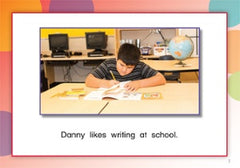 This is the third recent post in which we've been focusing on oral language development. You can see the two earlier posts
here
and
here
. Today, we're going to look at how oral language development ties into the
Common Core State Standards
and how the
Oral Language Development Series (OLDS)
can support students in meeting those standards.
This is the third recent post in which we've been focusing on oral language development. You can see the two earlier posts
here
and
here
. Today, we're going to look at how oral language development ties into the
Common Core State Standards
and how the
Oral Language Development Series (OLDS)
can support students in meeting those standards.
Taken from the OLDS Teacher's Guide (downloadable at the bottom of this post):
"The Common Core State Standards further underscore the need for oral language development. Divided into four strands—reading, writing, listening and speaking, and language—the standards provide clear guidance about the role of the language strand in connection to the other three strands. The CCSS states the following:
The inclusion of Language standards in their own strand should not be taken as an indication that skills related to conventions, effective language use, and vocabulary are unimportant to reading, writing, speaking, and listening; indeed, they are inseparable from such contexts. Education professionals need to incorporate language objectives into all aspects of classroom instruction, not just at a designated English Language Development time; further, they need to recognize the various registers of oral language, including the difference between playground English and academic English, and be given help developing strategies to develop academic English. Lastly, they need tools to use for this work that incorporate increasingly complex syntax and vocabulary that is contextualized.
"The Oral Language Readers were developed to address these areas of need, which were identified with the help of the research base on oral language development.
The Oral Language Readers provide exposure to alternative ways of constructing sentences, through interaction with text in one-on-one and small group settings. The books use a coding system that recognizes syntactical complexity rather than a level for reading. The coding system is explained in Language Structure Coding and Coding Key sections of this manual and can also be found on each of the readers."
Here is an example of the way that syntactical complexity increases in the Oral Language Development Series books. Each pane below is from the same corresponding page of a different language structure from the same topic, increasing in complexity:
The above pages are from (in order) the wordless Entry book, and Language Structures 1, 2, 3, 4, 5, and 6. The final level, LS 7, contains a variety of language structures from the other books. The following chart explains the structures used:

In the topic shown, At School , the location used in the prepositional phrases remains the same, while in other topics, it may change (e.g., Fruits and Vegetables uses both "at home" and "at school" and My Family uses various locations around the house). In the lateral books, the main character changes; in the At School laterals, Vicky is the main character instead of Danny; the idea of the laterals is to give more practice on a particular language structure level by "swapping out" one element of the sentence with another comparable one.
One exercise you can try with your students for even more additional practice is to have your students create their own laterals. For example, At School introduces the gerunds "reading," "writing," "playing," and "singing," and the predicate nouns "math," "lunch," and "school." All of these things are given as examples of things Danny likes (or Vicky likes). The book also introduces the locational prepositional phrase "at school."
You can ask your students put themselves in Danny's place and come up with more things that they like doing at school. If your student is at the level of Language Structure 1, the sentences can be simple: "[Student's name] likes painting." If a higher level is needed, model the sentences after the more complex language structure: "[Student's name] likes painting; however, [teacher's name] likes teaching."
For the language structure levels that contain prepositional phrases, you can also ask them about specific locations at school that can be used as alternate prepositional phrases: "[Student's name] likes lunch in the cafeteria ." or "Danny likes playing in the schoolyard ." The idea is to help the student recognize that words fall into categories, and that different words of the same category can be substituted for one another to build sentences with different meanings.
The Common Core State Standards for Grades 3 through 5 specifically state that students should be able to use and explain the function of different classes of words, from nouns, pronouns, verbs, adjectives, and adverbs in Grade 3, to relative pronouns in Grade 4, and conjunctions, prepositions, and interjections in Grade 5. The more exposure English learners have to practice with these building-blocks of language, the better equipped they will be!
For more information on the Oral Language Development Series (OLDS) , you can click below to download a summary of key points about the books and to view the free teacher's guide!
- Tara Rodriquez






















































![6 Fun and Easy Activities to Practice Sequencing [Grades K-1]](http://www.hameraypublishing.com/cdn/shop/articles/Red_Typographic_Announcement_Twitter_Post-5_bf1ae163-a998-4503-aa03-555b038d1b76_600x.png?v=1689961568)
![Leveraging Prior Knowledge Before Writing and Reading Practice [Grades 1–2]](http://www.hameraypublishing.com/cdn/shop/articles/Red_Typographic_Announcement_Twitter_Post-4_600x.png?v=1689961965)




